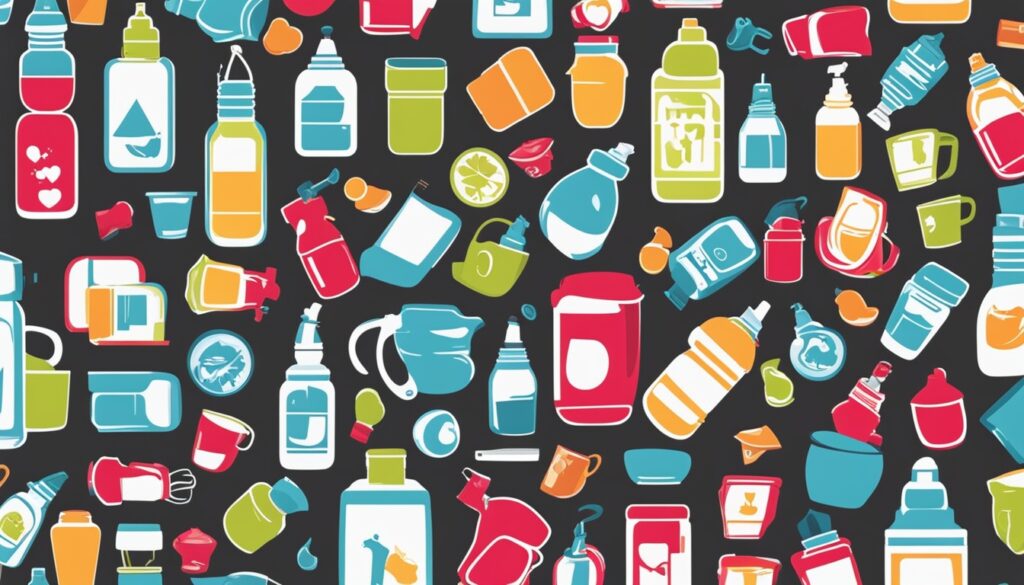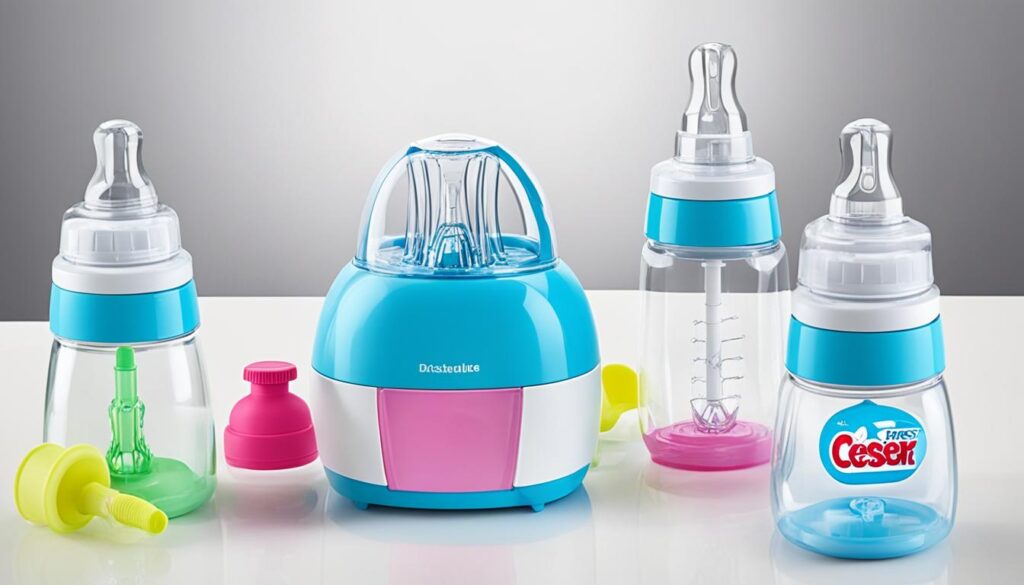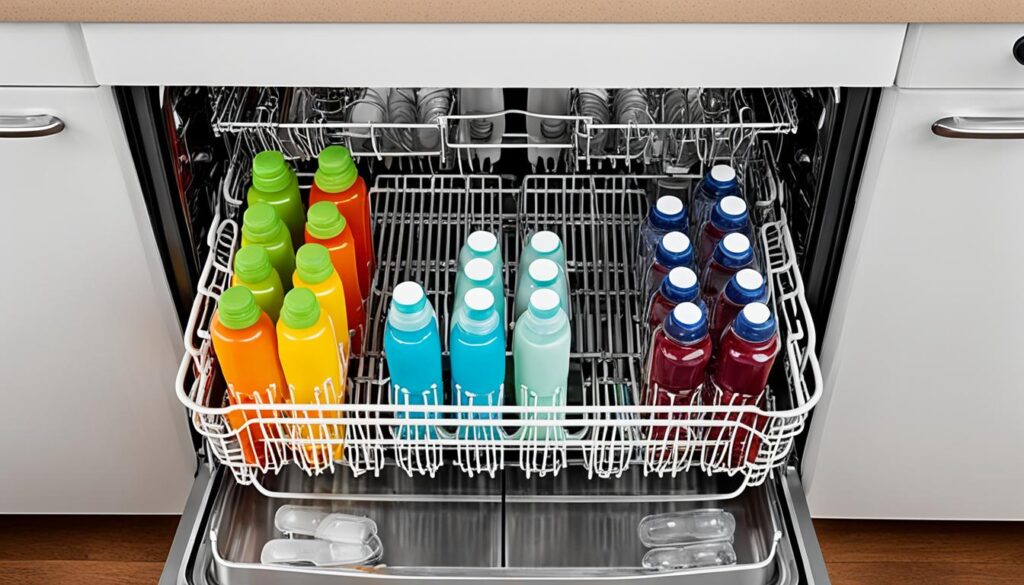As an Amazon Associate. I earn from qualifying purchases
As a parent, the dishwasher is a big help in cleaning your baby’s items. But, you might wonder if baby bottles can go in the dishwasher. The answer might surprise you.
Key Takeaways
- Most baby bottles are made to be dishwasher safe, but always check the manufacturer’s instructions.
- Take apart the bottles and put them on the top rack of the dishwasher for the best results.
- Use a gentle, baby-friendly detergent and the sanitizing or heavy wash cycle.
- Check for any residue or spots after the wash cycle and wash by hand if needed.
- Proper drying and storage of the clean bottles is key to keeping them in good condition.
Introduction
Caring for a baby is a full-time job, and busy parents often look for ways to save time. They want to simplify daily tasks. One area where modern conveniences can help is dishwashing. Many parents wonder if they can put baby bottles in the dishwasher, a time-saving option.
The good news is that most baby bottles can be washed in the dishwasher. But, there are a few extra steps to take. These steps ensure the bottles are thoroughly cleaned and sanitized. By following these guidelines, parents can use the dishwasher’s convenience while keeping baby care and bottle hygiene high.
The Benefits of Dishwashing Baby Bottles
Washing baby bottles by hand can be time-consuming and tedious for busy parents. Dishwashers offer a more efficient and thorough cleaning solution. They also sanitize the bottles to kill harmful bacteria.
- Time-saving: Dishwashers clean and sanitize multiple bottles at once, reducing the time spent on this chore.
- Thorough cleaning: Dishwashers use high heat and powerful water jets to remove stubborn residues from bottles and their components.
- Sanitization: The heat and steam from dishwashers kill germs and bacteria, making your baby’s bottles safe and clean.
By using dishwashers, parents can free up more time. They can focus on other important aspects of caring for their baby, like feeding, playing, and bonding.
“Dishwashers can be a real lifesaver for busy parents. They offer a quick and efficient way to clean and sanitize baby bottles without the hassle of handwashing.”
Read the Labels

Before putting your baby bottles in the dishwasher, make sure they’re safe for it. Using the wrong bottles can cause them to warp, degrade, or even melt. This can ruin their use and make them last shorter. Luckily, most baby bottles have symbols that tell you if they’re dishwasher safe.
Identifying Dishwasher-Safe Symbols on Baby Bottles
Check your baby bottles for these symbols to see if they’re dishwasher safe:
- A “dishwasher safe” text label
- A square with a cup and fork icon
- A square with a wine glass and water droplets
- A plate or several dishes with water droplets or dotted lines above
If you see a crossed-out dishwasher icon, wash the bottles by hand. Paying attention to these dishwasher safe symbols and bottle care instructions keeps your bottle materials safe and in good shape. This prevents any expensive damage.
“Proper care of your baby bottles is essential for maintaining their quality and safety. Always check the labels before putting them in the dishwasher.”
Rinse the Bottles
Before putting your baby’s bottles in the dishwasher, make sure to pre-rinse them with warm water. This step boosts the dishwasher’s cleaning power and gets rid of any leftover milk or formula. This can prevent dry, hard-to-clean residue later.
It’s key to rinse the bottles before washing to stop dried-on stuff from building up. This stuff can be a breeding ground for bacteria. By pre-rinsing the bottles, you let the dishwasher do its best job of cleaning. It won’t waste time on tough residue.
Here’s a quick guide to pre-rinse your baby’s bottles right:
- Use warm water to rinse the bottles, making sure every part gets wet.
- Focus on the bottle neck, nipple, and small spaces where residue can stick.
- Swish the bottles around to get rid of any leftover milk or formula.
- Don’t use hot water, as it can make dried-on stuff worse.
Pre-rinsing the bottles gets your dishwasher ready for a deep clean. It makes sure your baby’s bottles are as clean and safe as they can be.
Disassemble

To make sure your baby’s bottles get really clean, take them apart before washing. This lets you get into tight spots and clean every part well.
Taking Apart Bottle Components
Begin by taking off the bottle cap, nipple, and any extra parts like valves or rings. These small parts can hold onto milk or formula, so removing them lets the dishwasher clean them better. Carefully take apart each piece and put them in the dishwasher basket or mesh bag to keep them safe.
- Remove bottle caps, nipples, and other removable parts
- Disassemble each component to access hidden areas
- Place all pieces in the dishwasher basket or mesh bag
By taking apart your baby bottles before washing, you get a thorough cleaning. It also lets you access hard-to-reach areas where dirt might hide. This step keeps your baby’s bottles clean and safe for the next use.
“Taking the time to disassemble and thoroughly clean each bottle component is an essential step in maintaining a safe and healthy feeding routine for your little one.”
Place in a Basket or Mesh Bag
When washing your baby’s bottles in the dishwasher, it’s key to put the small parts in a dishwasher-safe basket or mesh bag. This keeps things like bottle nipples safe from getting damaged. They shouldn’t be put directly on the dishwasher rack.
Here’s why using a basket or mesh bag is a good idea:
- It keeps all the small parts together, so they don’t get lost or fall through the racks.
- The basket or mesh bag makes sure everything gets cleaned well.
- It also protects the fragile parts from the dishwasher’s water and racks.
By doing this, you can be sure your baby’s bottles will come out clean and ready for next time. It’s a simple way to keep your dishwasher-safe baskets and mesh bags in good shape.
| Benefits of Using a Basket or Mesh Bag | Explanation |
|---|---|
| Keeps components together | Prevents smaller parts from getting lost or falling through the racks |
| Maintains component integrity | Ensures thorough and even cleaning of all bottle parts |
| Provides additional protection | Safeguards fragile components from potential damage during the wash cycle |
Ensure Proper Placement

To get your baby bottles clean and dry, make sure they’re on the top rack in the dishwasher. Put the parts apart facing down to keep them away from the hot bottom of the dishwasher. This way, you avoid damage to plastic bottles and keep the materials safe.
Having the bottles face down lets any leftover water or soap go away. This means a better clean for your baby’s bottles. The dishwasher’s water jets can get into every corner, making sure everything is spotless and safe for your baby.
Top Rack Placement
When loading the dishwasher, remember to put the bottles on the top rack. This spot keeps them away from the hot bottom, avoiding heat damage. The water on the top rack is gentler, so your baby bottles come out perfect for the next use.
“Proper bottle placement is key to ensuring a thorough, damage-free clean in the dishwasher.”
Select the Right Cycle
When washing baby bottles in the dishwasher, picking the right cycle is key. It ensures they get a cleaning and sanitizing they need. Modern dishwashers often have cycles just for baby items, making it simpler.
Sanitizing Cycles for Effective Disinfection
Choose a sanitizing cycle if your dishwasher has one. These cycles use high temperatures to kill harmful bacteria. They reach up to 150°F (65.6°C) or more, giving a deep clean to your baby’s bottles.
The longer wash time and high heat make sure your baby’s bottles get a thorough cleaning. This is crucial for their safety.
Heavy Wash Cycles for a Deep Clean
If there’s no sanitizing cycle, go for a normal or heavy wash cycle. These cycles are longer and hotter than light ones. They’re perfect for cleaning baby dishwasher cycles.
With these cycles, your baby’s bottles get a deep clean. They remove all residue and bacteria, ensuring they’re safe for your baby.
Choosing the right dishwasher cycle means your baby’s bottles get a sanitizing and thorough cleaning. This ensures they’re safe and clean for your baby.
Use Baby Bottle-Friendly Detergent

Not all detergents are safe for cleaning baby’s bottles. Some have harsh chemicals or fragrances that can be harmful. It’s important to pick a gentle, baby-safe detergent without harsh additives.
Search for baby-safe detergents that are mild, without fragrances, and approved by pediatricians. These gentle formulas kill bacteria and residues without harsh chemicals. Always check the label to ensure it’s safe for baby bottles.
- Opt for baby-safe detergents without harsh chemicals and fragrances
- Choose gentle formulas that are effective yet gentle on baby’s bottles
- Avoid harsh chemicals that can leave behind harmful residue
- Look for detergents made for cleaning baby bottles
Using a baby-safe detergent ensures your baby’s bottles are clean and safe. Choose a gentle formula that cleans well without exposing your baby to harsh chemicals.
“Protecting your baby’s health should be the top priority when cleaning their bottles.”
Look for Residue
After running your dishwasher, check each baby bottle for leftover residue. Even with a dishwasher’s good cleaning, water hardness or some detergents can leave cloudy dishes and residue. If you see milk left behind, try another dishwasher cycle or handwashing.
Keeping your dishwasher in good shape is key for its efficiency. If your baby bottles always have residue after washing, your dishwasher might need a pro check. Fixing any issues can stop residue problems in the future.
| Issue | Potential Causes | Solutions |
|---|---|---|
| Inspecting for residue |
|
|
Remember, taking the time to thoroughly inspect your baby bottles after washing can help ensure they are truly clean and ready for your little one’s next feeding.
Dry and Store the Bottles
After washing and sanitizing your baby’s bottles in the dishwasher, make sure to dry and store them right. Leftover moisture can cause bacteria to grow, making the bottles less clean. It’s important to dry the bottles well to keep them safe for your baby.
Proper Drying Techniques
Let the bottles dry completely on a clean surface after the dishwasher cycle ends. Put the bottles upside down on a drying rack to let any water drain out. This step stops bacteria from growing and makes the bottles safe for storage.
Storing Baby Bottles
Once the bottles are dry, store them in a clean spot to avoid contamination. Keeping your baby bottles clean is key to stopping harmful bacteria from building up. Use a special cabinet or shelf for your bottles to keep them away from other items that could bring germs.
By drying and storing your baby’s bottles correctly, you keep them clean and safe. This gives you peace of mind and helps protect your baby’s health.
Is It Safe to Put Baby Bottles in the Dishwasher?
Cleaning your baby’s bottles can be a breeze with a dishwasher. Most baby bottles can go in the dishwasher if you follow the right steps. Knowing how to safely clean them can save you time and keep your baby safe.
First, check the labels for dishwasher-safe symbols or instructions. Some bottles can handle dishwasher heat, but others need to be washed by hand. Always follow the maker’s advice to keep your baby’s bottles safe.
Once you know your bottles are dishwasher-safe, get them ready. Rinse them, take apart what you can, and put them in a special basket or bag. Facing them down on the top rack helps get them clean.
Choose a sanitizing or heavy wash cycle to clean your baby’s bottles well. Use a special detergent made for baby bottles to avoid harmful residues.
After washing, check the bottles for any leftover dirt or spots. If they look clean and dry, you can store them for later. Keeping them dry and clean is key to stopping harmful bacteria from growing.
In short, yes, you can wash most baby bottles in the dishwasher. Just follow the steps and guidelines to keep your baby’s bottles clean and safe. This saves time and gives you peace of mind.
Handwashing Baby Bottles
Handwashing baby bottles is sometimes better than using a dishwasher. This is true for delicate bottles or those not marked as dishwasher-safe. Handwashing takes more time but ensures a deep clean and keeps the bottles safe.
- Start by taking apart the bottle, including the nipple, ring, and other parts.
- Put the parts in a sink or basin with warm, soapy water, making sure they’re fully covered.
- Use a soft brush or your hands to clean the bottles inside and out, focusing on tough spots.
- Rinse the bottles well under clean water to get rid of all soap.
- Let the bottles dry completely before putting them back together and storing them.
Handwashing might take longer, but it’s a good way to make sure your baby’s bottles are clean and safe. Taking the time to wash them by hand gives you peace of mind that your baby’s feeding items are ready to use.
Handwashing Baby Bottles
While dishwashers can clean most bottles, sometimes handwashing is needed. Handwashing is gentler, perfect for glass bottles or those with delicate parts. It ensures everything gets clean without a dishwasher.
Step-by-step guide for handwashing bottles
Handwashing baby bottles requires a few key steps. Start by taking apart the bottles and separating the parts. Rinse each piece under warm water to get rid of any leftover food or formula.
Next, use a bottle brush and mild soap to clean the inside and outside of the bottles. This makes sure they’re spotless. If there’s still some residue or smell, fill the bottle with a diluted bleach solution.
Let it sit for a few minutes, then rinse it well. Finally, lay the parts out to dry on a clean surface. This finishes the handwashing process.
FAQ
Can You Safely Clean Baby Bottles in a Dishwasher?
Yes, most baby bottles can go in the dishwasher for easy and effective cleaning. Just make sure to follow the maker’s instructions for safe materials and how to take them apart.
How can I ensure my baby bottles are thoroughly cleaned in the dishwasher?
Rinse the bottles with warm water to get rid of any leftover milk or formula before the dishwasher. Take the bottles apart and put the small parts in a special basket or mesh bag. This helps prevent them from getting lost or broken.
What cycle should I use when washing baby bottles in the dishwasher?
Use the sanitizing cycle if your dishwasher has one for baby bottles. This cycle gets really hot, often over 150°F (65.6°C), killing bacteria and cleaning the bottles well.
What type of detergent should I use for washing baby bottles in the dishwasher?
Choose detergents that are mild, don’t have a strong smell, and are okayed by doctors. These detergents clean well without leaving harmful chemicals behind.
Are there any instances when I should handwash my baby’s bottles instead of using the dishwasher?
Sometimes, handwashing is better. It’s gentler, especially for glass bottles or delicate parts. It also makes sure everything gets clean without a dishwasher.

